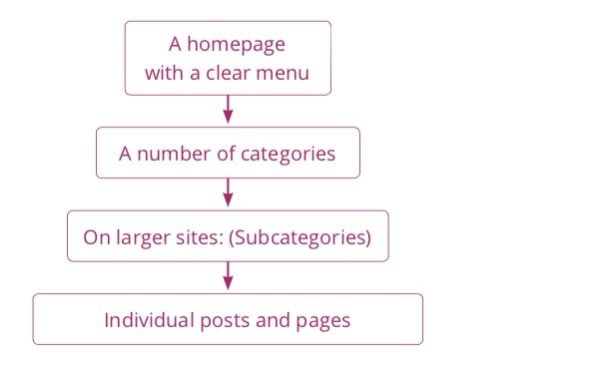A solid site structure helps your users and search engines navigate your site. On top of that, it will make clear what pages on your website are most important. Two pillars of a good site structure are organizing your site and internal contextual linking.
3.1. Organize your site
Organizing your site will help you create a navigation path from your homepage to your posts and pages. Adding categories and subcategories will bring order to chaos. Ideally, your site should be organized as such:

You should always make sure your homepage is straightforward to navigate. Cluttering the homepage with too many options will make your site more difficult to understand. Adding a clear menu and breadcrumbs helps your user navigate your site wherever they are.
3.2. Connect your content with contextual internal linking
Besides organizing your site, you need to link your content within your copy. We call this contextual internal linking because these links always appear within the context of a text. Internal linking is one of the most important aspects of WordPress SEO.
Contextual internal links set up a network of pages, pointing your users to related content. For example, in a post on keyword research, linking to an article on SEO copywriting makes a lot of sense. For search engines, these links provide insight into how pages are related.
Always ensure that the number of links to a page reflects the importance of that page. Our ultimate guides get a lot of links from individual posts about related topics. This helps users and search engines understand that these guides are crucial pillars of our site.
When adding a contextual internal link, make sure the link makes sense within the current page’s context. Moreover, always use anchor texts which accurately describe the page you’re linking to. This gives users and search engines the context to assess whether the link is valid. The internal linking tool in Yoast SEO Premium helps you connect your content by automatically suggesting relevant links.
3.3. Manage your categories and tags
WordPress has two default ways of structuring your content: categories and tags. Categories add hierarchy to your content and group topics broadly. On a website about cooking, pasta could be a category. Tags are non-hierarchical and can be used to describe your post in more detail. Dinner party themes, for example, could be a tag.
When setting up your site structure, pick several main categories. Adding them to your menu can be a good idea, especially if you only have a blog. A different setup might make more sense if you have a blog and several products. Make sure your categories are roughly the same size. If your categories become too big, make subcategories. Your category pages can be great landing pages, especially for ecommerce sites — more on that in our ecommerce SEO guide.
Tags are helpful for users exploring topics, but they are often misapplied. It’s important not to use too many tags and use them more than once or twice. Remember, you want to group your content, not just describe it.
If you want to structure your content differently, WordPress also allows you to create custom taxonomies. Always consider carefully whether your custom taxonomy groups content in a way that makes sense and helps your visitors.


No comments:
Post a Comment